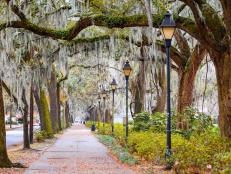10 of the World's Most Magical Zoos
You don't have to go on safari to see animals up close and personal.

Photo By: San Diego Convention & Visitors Bureau
Photo By: Shutterstock/Michael Gancharuk
Photo By: Mr. Nixter
Photo By: iStockphoto.com/JohnCarnemolla
Photo By: iStockphoto.com/Stephen Pawlawski
Photo By: Shutterstock/asharkyu
Photo By: Shutterstock/forksandspoons
Photo By: VisitIndy.com
Photo By: Shutterstock/sittitap
Photo By: Shutterstock/photobeginner
San Diego Zoo (San Diego, California)
Nestled in San Diego’s lush Balboa Park, the 100-acre San Diego Zoo is one of the largest in the world, housing more than 3,700 animals and 650 species and subspecies. It’s famous for cageless, open-air exhibits that recreate animals’ natural habitats, from the Australian outback to the African savanna. Also famous: The zoo’s considerable conservation and species-preservation efforts. Thanks to the work of more than 200 scientists spread across 35 countries, the San Diego Zoo has successfully reintroduced more than 30 endangered species back into the wild and saved the habitats of 50 field sites.
Singapore Zoo (Singapore)
This world-renowned wildlife park is home to roughly 315 different species, many of them endangered or threatened. But the main draw at the Singapore Zoo is the extensive community of orangutans, which constitute the largest captive colony of its kind in the world. Guests can actually meet some of the park’s ape residents at "Breakfast with an Orangutan," the long-running program at Ah Meng Restaurant. Between bites at the buffet, visitors are invited to get up close and personal (and snap a photo with) orangutans like Ishtar, granddaughter to the Singapore Zoo’s most famous ape resident, Ah Meng, who passed away in 2008.
Henry Doorly Zoo and Aquarium (Omaha, Nebraska)
Omaha may not be the first place one thinks of when considering world-class zoos, but Nebraska’s Henry Doorly Zoo and Aquarium more than fits the bill. It’s an enormous place, spanning 130 acres, and is home to the largest cat complex in North America with more than 20 indoor and outdoor enclosures holding leopards, cougars, jaguars, African lions, and Bengal, Indochinese and Siberian tigers. As of 2016, the zoo is also home to African Grasslands, a 28-acre, $73 million exhibit that's home to six African elephants.
Taronga Zoo (Sydney, Australia)
Just a 15-minute ferry ride from downtown Sydney, Taronga Zoo might have the best view of any zoo in the world. Here, you can watch giraffes nibble on greenery while the Sydney Opera House gleams in the distance. The zoo is also home to a vibrant chimpanzee colony that can trace its history back eight decades. Currently 19 members strong, the group’s enclosure was given a sparkling $7.1 renovation in 2009.
Woodland Park Zoo (Seattle, Washington)
This 92-acre zoological garden’s gorilla habitat, which opened in 1979, is widely considered the world’s first immersion exhibit. Today, Woodland Park Zoo is home to a wide variety of other similarly immersive exhibits, including the Tropical Asia biome, which features Asian small-clawed otters and tropical birds. There's also the Northern Trail exhibit, which is landscaped to look like an actual trail in Alaska’s Denali National Park and houses timber wolves, Arctic foxes, grizzly bears, mountain goats, Steller's sea eagles and Roosevelt elk.
Living Desert Zoo and Gardens (Palm Desert, California)
You won’t find anything tropical at the Living Desert Zoo and Gardens, which is dedicated solely to the flora and fauna of the world’s many deserts. It’s also a nature preserve, protecting more than 1,000 acres of Sonoran desert. In addition to the many animals on display—which include rhim gazelles, mountain lions, meerkats, cheetahs, striped hyenas and giraffes—guests can take a docent-led tour of the on-site Tennity Wildlife Hospital and Conservation Center and observe medical procedures and examinations.
Brookfield Zoo (Brookfield, Illinois)
The Brookfield Zoo may be located in the tame suburbs of Chicago, but it’s plenty wild. Spread out over the park’s whopping 216 acres are several immersive exhibits, including the Great Bear Wilderness, where guests can spot hulking American bison in a rolling prairie setting; majestic bald eagles in an expansive mesh aviary; and the park’s enormous resident grizzly bears, which can weigh more than 1,000 pounds.
Indianapolis Zoo (Indianapolis, Indiana)
Though small compared to some zoos, the Indianapolis Zoo packs a lot into its 64 acres. Organized around the concept of biomes—areas that share a similar climate, flora and fauna—the zoo allows visitors to travel from the plains of Africa to the forests of Alaska, all without leaving the property. The Indianapolis Zoo is also the home of the Simon Skjodt International Orangutan Center, an award-winning facility specially designed to stimulate apes not only on a physical level, but also socially and intellectually.
Wellington Zoo (Wellington, New Zealand)
At just 32 acres, New Zealand’s Wellington Zoo is small, but mighty. In addition to animals from around the globe, such as Australian bearded dragons, South American capuchin monkeys and African cheetahs, the zoo is also home to native New Zealand creatures such as the alpine Kea parrot and the flightless kiwi bird. One kiwi—a one-legged male named Tahi—is the zoo’s unofficial mascot, and guests can hang out with him during the park’s daily Kiwi Talk session.
Bioparc Valencia (Valencia, Spain)
You won’t find many cages or panes of glass at Bioparc Valencia, a modest 25-acre park in Valencia, Spain. Instead, the architects of this handsome facility used rivers, ponds, streams and rocks to keep visitors at a safe distance. Animals that naturally live together in the wild share enclosures, and gentle species—like lemurs—are allowed to come right up to guests if they fancy a hello. Just remember, no touching or feeding the animals.







